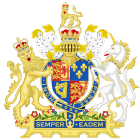Stamp Act 1712 facts for kids
| Act of Parliament | |

|
|
| Long title | An Act for altering the Stamp Duties upon Admissions into Corporations or Companies; and for further securing and improving the Stamp Duties in Great Britain. |
|---|---|
| Citation | 10 Ann. c. 18 (Ruffhead c. 19) |
| Territorial extent | Great Britain |
Quick facts for kids Dates |
|
| Royal assent | 22 May 1712 |
| Commencement | 5 July 1765 |
| Repealed | 1 July 1855 |
| Other legislation | |
| Repealed by | Revenue Officers' Disabilities Removal Act 1874 |
|
Status: Repealed
|
|
The Stamp Act 1712 was a law made in Great Britain. It started on August 1, 1712. This law created a new tax, especially for people who published newspapers. Newspapers had to pay this tax, which made them more expensive.
This tax was put on each newspaper. This meant cheaper papers and those read by many people were hit harder. Wealthy people felt the tax less because it was a smaller part of what they paid. The tax went up in 1797, then down in 1836. It finally ended in 1855. This allowed newspapers to become much cheaper. The tax was in place until it was officially stopped in 1855.
At first, the tax was one penny for a whole newspaper sheet. It was a halfpenny for a half sheet. Also, each advertisement cost one shilling. This tax made some publishers worried. They feared it would stop them from writing freely. A famous writer named Jonathan Swift complained about this new tax. Besides newspapers, the law also taxed pamphlets, legal papers, business bills, and other documents. Some people believe this tax caused a decline in English writing that criticized the government. For example, a popular newspaper called The Spectator stopped publishing the same year the tax began. Over time, the taxes increased and affected even more types of materials. This continued until the tax was removed in 1855.
What the Act Did
In its first year, the Stamp Act collected £5,536 in taxes. This tax amount increased over the years. The highest tax was four pence on all newspapers. It was three shillings and six pence on all advertisements. Publications that the government supported, or started supporting after the law, did not have to pay the tax.
The Newspaper Tax
The newspaper tax grew bigger with the Newspaper and Stamp Duties Act 1819. This new law included all publications that sold for less than six pence. It also covered those that shared opinions about news. And it included those published more often than every twenty-six days. The newspaper tax was finally removed on July 1, 1855.
Why the Act Was Made
The government said the tax was to raise money for the English state lottery. But it also had other goals. It helped the government keep track of how many newspapers were being printed. It also aimed to stop people from publishing writings that could "excite hatred and contempt of the Government and holy religion."
By law, all newspapers already had to print the name and address of their owner. This made it easy for the government to collect the tax. It also let them see where legal publications were coming from. To avoid the tax, some writers asked members of the Parliament of Great Britain for their support. This meant that some publications became popular or disappeared depending on which political party was in power. This also led to people not trusting newspapers very much at that time.

